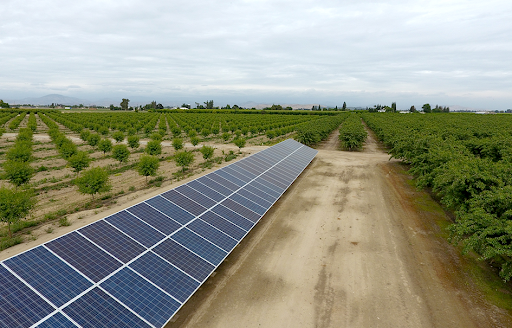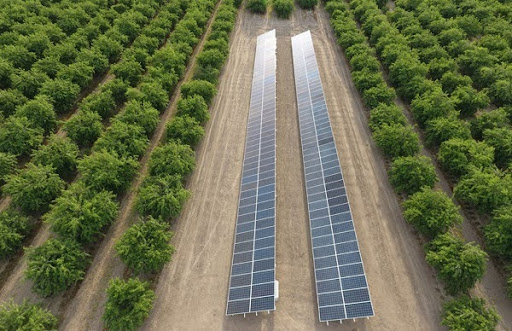How Much Space Do You Need For Ground-Mount Solar?
Key Takeaways
- A typical ground-mount solar panel requires around 18 square feet of space.
- System size, panel efficiency, and geographical location are key factors affecting space needs.
- Local zoning laws can impact the available area for solar installations.
- Nuance Energy’s ground-mount solar solution is designed to lower costs and speed up installation.
Factors That Affect Space Requirements for Ground-Mount Solar
- Number of Solar Panels: Each panel typically occupies between 1.6 and 2.5 square meters.
- Mounting Angle and Spacing: Optimal angles usually range from 25 to 35 degrees to allow for maximum sunlight exposure throughout the day. Adequate spacing is also necessary to prevent shading and for maintenance.
- Site Conditions: Factors such as terrain type, soil stability, and obstacles (like trees or buildings) can affect both the installation area and the efficiency of energy production.
- Local Regulations and Permits: Local zoning laws and regulations can impose restrictions on where and how ground-mounted solar systems can be installed.
- Future Scalability: Systems should be able to accommodate potential expansions in capacity without requiring significant redesign or additional land acquisition.
| Nuance Energy is your superior solution for Ground Mount solar. Our patented foundation technology, in the Osprey PowerRack™, allows for rapid installation using only handheld tools, significantly reducing both time and costs compared to traditional racking systems. This cutting-edge technology works for residential and commercial installations, and Nuance Energy empowers solar installers to take back control of their installation schedules, control project COGS, gain market share, increase the speed of installation, and reduce costs and labor. In contrast, a traditional ground mount is much more unpredictable, slower, and costly.
Find out how Nuance Energy can accelerate your solar projects with the Osprey PowerRack™ line, and boost your profitability. Contact us today to discuss our innovative ground-mount solutions. |
Estimating Space For Ground-Mount Solar

Each row of solar panels also needs to have a gap for ease of maintenance.
1. Determine the Number of Solar Panels
The first step is to decide how many solar panels you intend to install. Each panel requires about 18 square feet of space.
Example: For a system with 20 panels, the total area needed would be:
Total Area = 20 panels × 18 sq ft panel = 360 sq ft
2. Consider Mounting Systems and Ground Clearance
The type of mounting system affects space requirements. Ground-mounted systems can be either standard mounts or pole mounts.
- Standard Ground Mounts: Typically use multiple anchors and require more horizontal space due to their fixed position.
- Pole Mounts: Provide greater clearance and may require less ground area but need vertical space for the pole.
Example: A standard ground mount for 20 panels might need an additional 10% for spacing and maintenance:
Adjusted Area = 360 sq ft + (0.10×360) = 396 sq ft
3. Account for Spacing Between Panels
Generally, a spacing of 3-5 feet between rows is recommended.
Example: If each row of panels is spaced 4 feet apart, and you have 5 rows:
Total Spacing Area = (5−1) × 4 ft = 16 ft
This would add 64 square feet if rows are arranged in a linear fashion.
4. Future Scalability Considerations
It’s wise to allocate extra space for additional panels or equipment.
Example: If you anticipate needing an extra 10 panels in the future, calculate the additional area:
Future Area = 10 panels × 18 sq ft panel = 180 sq ft
This would bring your total estimated area to:
Total Estimated Area = 396 + 64 + 180 = 640 sq ft
Practical Tips for Maximizing Space Efficiency

Use high-quality panels to generate energy more efficiently.
- Choose Optimal Locations: Select areas with maximum sun exposure and minimal shading from trees or buildings.
- Use Adjustable Mounting Systems: Implement single-axis or dual-axis tracking systems to follow the sun’s movement and increase energy capture.
- Optimize Panel Orientation: Align panels to face true south (in the Northern Hemisphere) to maximize sunlight exposure.
- Consider Vertical Installations: In limited spaces, install vertical solar panel installations on walls or fences to maximize energy production.
- Use Lightweight Materials: Lightweight and portable mounting structures can be easily relocated or adjusted as needed.
- Evaluate Ground Conditions: Assess soil stability and terrain type to determine the best mounting solution and minimize land preparation costs.
- Choose Efficient Panel Types: Choose high-efficiency solar panels that require less space for the same energy output.
Why Nuance Energy’s Ground-Mount Solar Solutions Are Ideal
- Innovative Racking Technology: Our advanced racking system Osprey PowerRackTM requires no heavy equipment, ground screws, or concrete, which significantly simplifies installation and reduces costs.
- Cost Efficiency: Its modular design allows for quick assembly – a small team (3-4 people) can assemble a 10 kW structure in about an hour.
- Versatile Applications: Our systems are adaptable to various environments, including agricultural fields, landfills, and temporary setups for disaster response.
- Environmental Considerations: The use of earth anchor foundation technology preserves soil stability and minimizes environmental impact, which makes it suitable for fragile or contaminated lands.
- Transportability: The modular design allows for easy relocation, which is advantageous for industries like mining.
Frequently Asked Questions (FAQs)
How much space do I need for a ground-mounted solar system?
The space required varies based on system size and configuration. Generally, a 4-5 kW system requires about 25-35 square meters (approximately 270-375 square feet) of open land.
Can I install ground-mounted solar panels in a small yard?
If your yard is small, you may not have enough space for a sufficient number of panels to meet your energy needs. Ground-mounted systems are best suited for properties with ample open land.
Are there any local regulations that affect space requirements?
Yes, local zoning laws may impose restrictions on how close you can build to property lines and how much land can be used for solar installations.
What are the benefits of ground-mounted solar systems compared to rooftop systems?
- They can be positioned optimally for maximum sunlight exposure.
- They are easier to access for maintenance and cleaning.
- They allow for larger installations without restrictions imposed by roof size or angle
How does Nuance Energy’s system reduce installation times?
Our Osprey PowerRackTM is 100% modular and can be installed with just handheld tools so installers can assemble it much faster.
Save Time & Money on Your Next Solar Project
Request a QuoteRECENT POSTS
- DPW Solar vs Nuance Energy Mounted Solar Options: Cost & Benefits
- Geotechnical Report Cost & Requirements For Solar Projects
- Are Solar Panels Worth It In Nevada? Costs & Options
- OSPREY PowerRack Ground Mount System Compatibility: Single- and Dual-Axis Trackers
- Rammed Earth Foundation For Solar Arrays: Cost, Pros & Cons
- Agrivoltaics Explained: Solar & Agriculture Combined
- Large Scale Solar Systems Options: Pros & Cons
- Best Solar Options For Farms & Agriculture: Cost, Pros & Cons
- Unirac vs MT Solar Mounted Options: Cost & Benefits
- IronRidge vs Grengy Mounted Solar Options: Cost & Benefits

